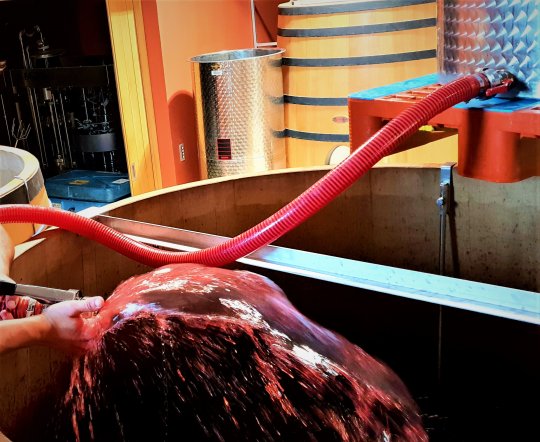Rack and return (délestage)
The rack and return procedure improves the exchange between the liquid phase and the solid phase (the marc) in the vat. To accomplish this, the juice is transferred to a buffer tank, then sent from the buffer tank over the marc cap with a pump with a high enough flow rate to completely destructure and submerge it. The marc cap then gradually reforms in the vat. A period of time between emptying and refilling is sometimes permitted to allow time for the juice present in the pomace to drain.
This method allows a fairly significant extraction of compounds. Other alternatives exist regarding methodology, particularly the juice's return to the tank using a tourniquet, and are generally gentler.
On what type of wine should it be used?
Used as defined here, it is a fairly powerful extraction method. It should therefore be used sparingly and only on grapes that have the potential. There are three questions to ask yourself when choosing whether or not to rack and return:
-
Are the grapes sufficiently ripe? It is important to avoid its use on plots that are only moderately or insufficiently ripe. The reason being that with poor seed ripeness, this is likely to result in the extraction of poorly polymerized tannins that can be very harsh and bitter on the palate, as well as a possible appearance of vegetal aromas. Moreover, if ripeness has not been reached, the seeds will not be sufficiently lignified, which facilitates the extraction of their tannins.
-
Are the grapes healthy? In the event that the harvest is botrytized, high extraction never improves the quality of the wine. Similarly, grapes that have undergone significant water stress, resulting in particular in the presence of withered berries, racking and returning is not recommended.
-
What is the desired final wine profile? Racking and returning often leads to more structured wines, so it should be avoided for lighter wine profiles and/or grapes that do not have the appropriate potential, at the risk of extracting less qualitative compounds.
**At what stage should it be carried out in the fermentation process?
Two rack and returns are possible during alcoholic fermentation. One after the formation of the marc cap, i.e. at a density of approximately 1075. A second one can be carried out 48 hours later, which usually corresponds to a density of around 1040. Below this density, racking and returning is less selective and the risks of extracting less desirable compounds become significant.

